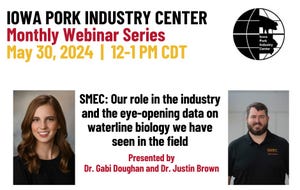Is PoAstV4 a primary cause of respiratory disease in pigs?
Information will assist veterinarians in the accurate diagnosis of PoAstV4 in pigs showing clinical signs of respiratory disease.
January 29, 2024
.jpg?width=850&auto=webp&quality=95&format=jpg&disable=upscale)
In December 2023, the Swine Health Information Center funded a study to investigate porcine astrovirus 4 as an emerging pathogen capable of causing respiratory illness in pigs. Mike Rahe, North Carolina State University, is leading the collaborative investigation to define the pathogenesis of PoAstV4 infection in weaned pigs under experimental conditions. Previous studies have shown evidence of PoAstV4 in respiratory tract lesions but the direct contribution of PoAstV4 to clinical disease is poorly understood.
The newly funded study seeks to understand if PoAstV4 is a primary cause of respiratory disease, characterize the course of infection over time, and provide a foundation for rapid and accurate identification of respiratory illness in pigs. Investigating the production impacts of potentially emerging pathogens is part of the SHIC mission to define risks to herd health and minimize disease impact.
In a 2022 SHIC-funded study, a retrospective analysis of porcine respiratory disease cases submitted to the Iowa State University VDL from Jan. 1, 2019, to Aug. 1, 2022, was conducted to evaluate the presence of PoAstV4 within microscopic lesions consistent with viral infection of airways. PoAstV4 RNA was detected in affected respiratory epithelium in 73% (85/117) of evaluated cases. This was the first report associating PoAstV4 with respiratory pathology in neonatal and weaned pigs. The next step of research is to define the ability of PoAstV4 to cause clinical respiratory disease and associated lung lesions in naïve pigs.
In the 2023 SHIC-funded study, a collaborative effort between researchers at North Carolina State University, the USDA National Animal Disease Center, Iowa State University and University of California Santa Cruz, work is underway to evaluate PoAstV4 as a causative agent of respiratory disease in high health, colostrum deprived, caesarean-derived pigs. Utilizing these high health pigs avoids potential exposure to PoAstV4 and the transfer of PoAstV4 maternal antibodies from the sow to piglets.
Pigs will be evaluated for the presence of clinical respiratory disease, evidence of gross and microscopic lesions, and presence of virus in multiple tissue types. Characterizing aspects of infection such as location of lesions, duration, and peak virus quantity in tissues over time helps to inform veterinarians how to sample suspect cases for accurate diagnosis. Further, analysis of the immune response to PoAstV4 under a controlled setting will provide information on antibody production.
This information will be important to assist veterinarians in the accurate diagnosis of PoAstV4 in pigs showing clinical signs of respiratory disease without a known etiology. Knowledge gained from the one-year study will be shared with producers and veterinarians as soon as it becomes available.
You May Also Like



